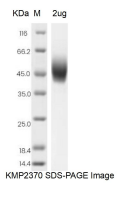Mouse CD274 Protein, Fc Tag
-
产品编号
KMP2370
-
别名
程序性死亡蛋白配体-1, programmed cell death 1 ligand 1, CD274
-
规格
- 50ug
- 100ug
- 200ug
| Alias | 程序性死亡蛋白配体-1, programmed cell death 1 ligand 1, CD274 |
| Catalog Number | KMP2370 |
| Product Description | The Mouse CD274 Protein(KMP2370) is produced in HEK293 Cells and the target gene encoding Phe19-Thr238 is expressed with a Fc tag at the C-terminus. |
| Molecular Name | CD274 |
| Species | Mouse |
| Host | HEK293 Cells |
| Size | 50ug, 100ug, 200ug |
| Purity | >95% as determined by SDS-PAGE |
| Purification | Affinity purification |
| Endotoxin | <1.0 EU/ug determined by the LAL method |
| Formulation | 20mM PB, 150mM NaCl, pH7.4 |
| Background | Mouse Programmed cell death 1 ligand 1(Cd274,PD-L1), is a member of the growing B7 family of immune proteins.It involved in the costimulatory signal essential for T-cell proliferation and IFNG production in a PDCD1-independent manner. Interaction with PDCD1 inhibits T-cell proliferation by blocking cell cycle progression and cytokine production.B7-H1 has been identified as one of two ligands for programmed death1(PD1), a member of the CD28 family of immunoreceptors. B7-H1 is constitutively expressed in several organs such as heart, skeletal muscle B7-H1 expression is upregulated in a small fraction of activated T and B cells and a much larger fraction of activated monocytes. The costimulatory function of B7-H1 is critical for enhancing maturation and differentiation of T-cells in lymphoid organs.B7-H1 expression is also induced in dendritic cells and keratinocytes after IFN gamma stimulation. Interaction of B7-H1 with PD1 results in inhibition of TCR-mediated proliferation and cytokine production. The B7-H1:PD1 pathway is involved in the negative regulation of some immune responses and may play an important role in the regulation of peripheral tolerance. |
| SDS-PAGE |  |
| Predicted Molecular Weight | 24.76 kDa |
| Storage Condition | Aliquot and store at -20℃ to -80℃. Avoid repeated freezing and thawing cycles. |
| Shipping Condition | In general, the proteins are provided as lyophilized powder which are shipped at ambient temperature. They are shipped out in dry ice if supplied in liquid form. |
| Uniprot ID | Q9EP73 |
| References | 1.J. Exp. Med. 192:1027-1034 (2000) 2.Blood 97:1809-1816 (2001) 3.J. Exp. Med. 197:1083-1091 (2003) 4.Proc. Natl. Acad. Sci. U.S.A. 99:12293-12297 (2002) 5.Nature 534:402-406 (2016) |
| Function | Plays a critical role in induction and maintenance of immune tolerance to self . As a ligand for the inhibitory receptor PDCD1/PD-1, modulates the activation threshold of T-cells and limits T-cell effector response. Through a yet unknown activating receptor, may costimulate T-cell subsets that predominantly produce interleukin-10 (IL10). The PDCD1-mediated inhibitory pathway is exploited by tumors to attenuate anti-tumor immunity and escape destruction by the immune system, thereby facilitating tumor survival . The interaction with PDCD1/PD-1 inhibits cytotoxic T lymphocytes (CTLs) effector function . The blockage of the PDCD1-mediated pathway results in the reversal of the exhausted T-cell phenotype and the normalization of the anti-tumor response, providing a rationale for cancer immunotherapy . |





 0
0
